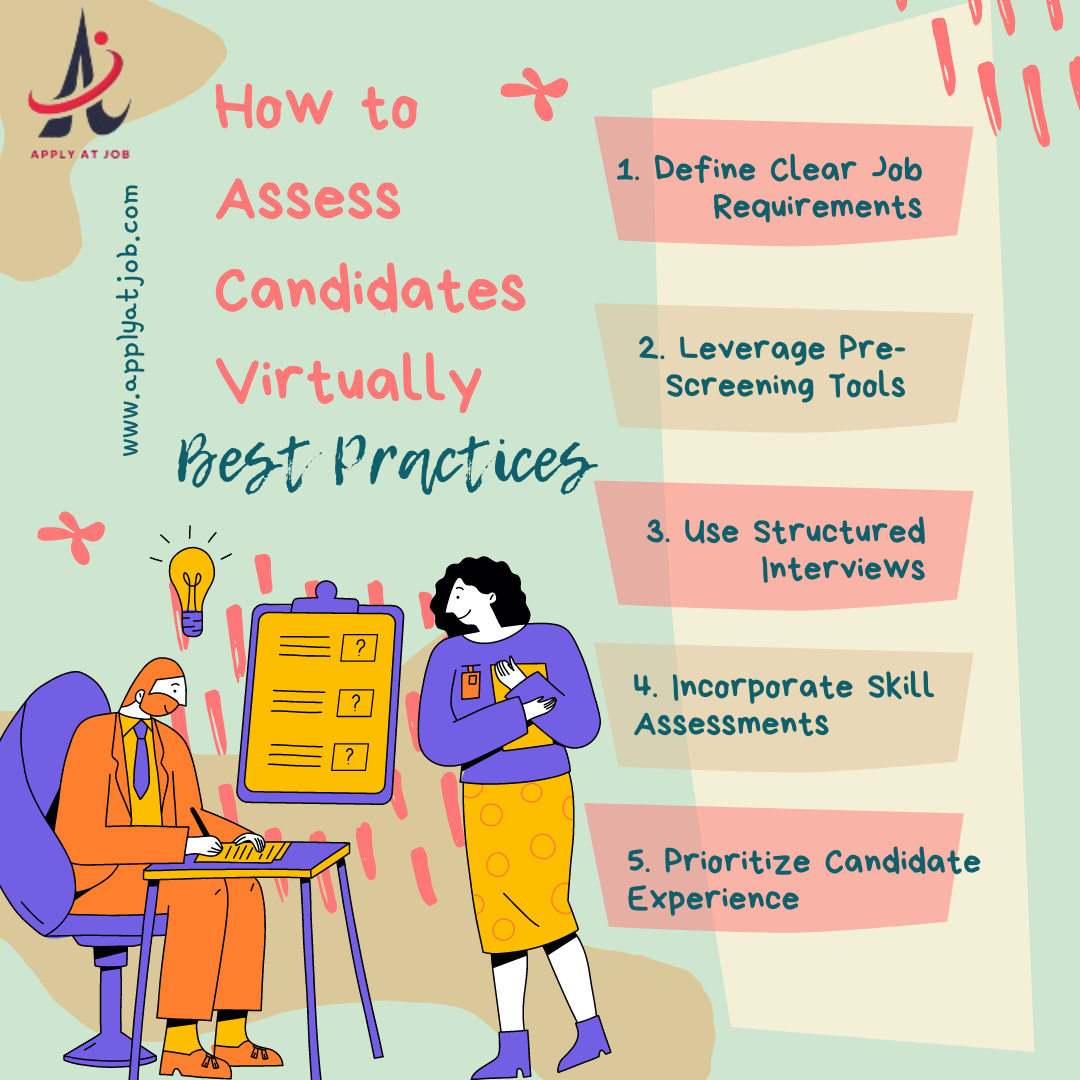
The Best Ways to Evaluate Candidates Virtually:
The recruitment landscape has changed due to the shift to virtual hiring, which has brought with it both new opportunities and challenges. Effective candidate assessment in a virtual setting necessitates a combination of technology, well-defined procedures, and strategic planning. We at APPLYATJOB are here to provide best practices for digitally evaluating candidates because we are aware of the subtleties of virtual recruitment.
1. Clearly Specify the Job Requirements:
It is essential to have a job description in place before beginning the virtual assessment process. Clearly state the qualifications, experience, and abilities needed for the position. This lucidity guarantees that candidates and recruiters have the same expectations.
Make thorough job descriptions: Indicate the necessary qualifications, soft abilities, and technical skills.
Determine the essential competencies: Establish which fundamental qualities and skills will be evaluated in the virtual interviews.
2. Make Use of Pre-Screening technologies:
By streamlining the preliminary steps of candidate evaluation, pre-screening technologies guarantee that only eligible applicants move on to the interview stage.
Applicant tracking systems (ATS): Utilize an ATS to screen applications according to predetermined standards, like training, experience, and qualifications.
Automated Screening Tools: Programs such as Pymetrics or HireVue evaluate candidates based on how they answer standardized questions, offering a preliminary assessment of their eligibility.
3. Employ Structured Interviews:
These methods guarantee impartiality and uniformity throughout the evaluation procedure. You may compare the responses of all the candidates in an unbiased manner if you ask them the identical questions.
Create a bank of questions: Make a list of inquiries covering technical proficiency, ability to solve problems, and cultural fit.
Apply a scoring guideline: To help remove prejudice, create a rubric that will be used to evaluate candidates' responses based on predetermined criteria.
4. Incorporate Skill Assessments:
Skill assessments provide a practical way to evaluate candidates’ abilities. These assessments can range from technical tests to real-world problem-solving exercises.
Technical assessments: Platforms like Hacker-Rank, Codility, and Code-Signal allow candidates to complete coding challenges or technical tasks relevant to the job.
Work samples: Ask candidates to complete a task or project that simulates the work they would do in the role. This could include writing a piece of content, designing a mockup, or analyzing a dataset.
Behavioral assessments: Use tools like Vervoe or Criteria to assess candidates’ soft skills, such as communication, teamwork, and leadership.
5. Make Use of Video Interviewing Platforms:
These platforms are essential to virtual hiring since they enable distant, in-person interviews.
Make use of trustworthy platforms: Use apps like Zoom, Microsoft Teams, or Google Meet instead; these provide capabilities like screen sharing, recording, and high-quality audio and video.
Get applicants and interviewers ready: Make sure everyone has tested their equipment and is familiar with the platform. Give candidates guidelines and pointers to ensure a successful interview process.
6. Assess Cultural Fit:
It's critical to evaluate candidates' cultural fit with your company's ideals and workplace culture. In a virtual environment, this can be difficult, but with the correct strategy, it is possible.
Pose situational queries: Ask questions that will show how applicants respond to real-world situations and fit in with the culture of your organization. For instance, find out how they handle stress, work in a team, or resolve conflicts.
Apply behavioral interviewing methods: The STAR approach (Situation, Task, Action, Result) facilitates applicants in offering well-organized answers that emphasize their prior experiences and actions.
7. Hold Panel Interviews:
Panel interviews can lessen individual biases and offer a variety of viewpoints to the assessment process. Panel interviews can be arranged virtually with ease by using video conferencing software.
Members of a diverse panel: Incorporate team members from various divisions or tiers to obtain a holistic understanding of the applicant's suitability for the position and organization.
Organize inquiries: Make sure every panelist has a particular area of expertise, such as problem-solving techniques, cultural fit, or technological know-how.
8. Make Use of Digital Whiteboard Tools:
These tools can mimic in-person brainstorming sessions for jobs requiring creative thinking and teamwork.
With the use of Miro and MURAL, applicants can work together to solve problems, visually communicate their ideas, and exhibit how they think.
Interactive exercises: Provide tasks where participants must use a digital whiteboard to sketch strategies, make flowcharts, or draw diagrams.
8. Use Digital Whiteboard Tools:
For tasks requiring collaboration and creative thinking, these tools can simulate in-person brainstorming sessions.
Candidates can collaborate to solve challenges, visually communicate their ideas, and demonstrate their thought processes by using MURAL and Miro.
Engaging activities: Assign assignments that require participants to create flowcharts, diagrams, or strategies on a digital whiteboard.
10. Take Into Account Asynchronous Interviews:
In an asynchronous interview, candidates can record their answers to pre-formulated questions whenever it is most convenient for them. Candidates from different time zones can be accommodated and initial screening can be done with great benefit from this manner.
Websites such as Spark Hire and my Interview: With the use of these tools, applicants can record video responses, which recruiters can access at any time.
Make sure the questions are pertinent and understandable so that applicants have enough knowledge to provide well-considered answers.
11. Make the Candidate Experience a Priority:
Attracting top talent requires a great candidate experience. Make sure the virtual evaluation procedure you use is open to candidates and easy to understand.
Unambiguous communication Inform candidates of the next steps, schedule, and interview procedure. Give them tools and advice on how to be ready for online interviews.
Recommendations: Regardless of the result, provide candidates with helpful criticism. This can improve your employer brand and shows that you value their time and work.
Conclusion:
Virtual candidate evaluation calls for a trifecta of technology, methodical procedures, and candidate experience management. You can guarantee a comprehensive and equitable assessment process by putting these best practices into practice, which will eventually result in better hiring decisions. Our goal at APPLYATJOB is to provide you with the confidence and success you need to successfully navigate the virtual recruitment environment.




